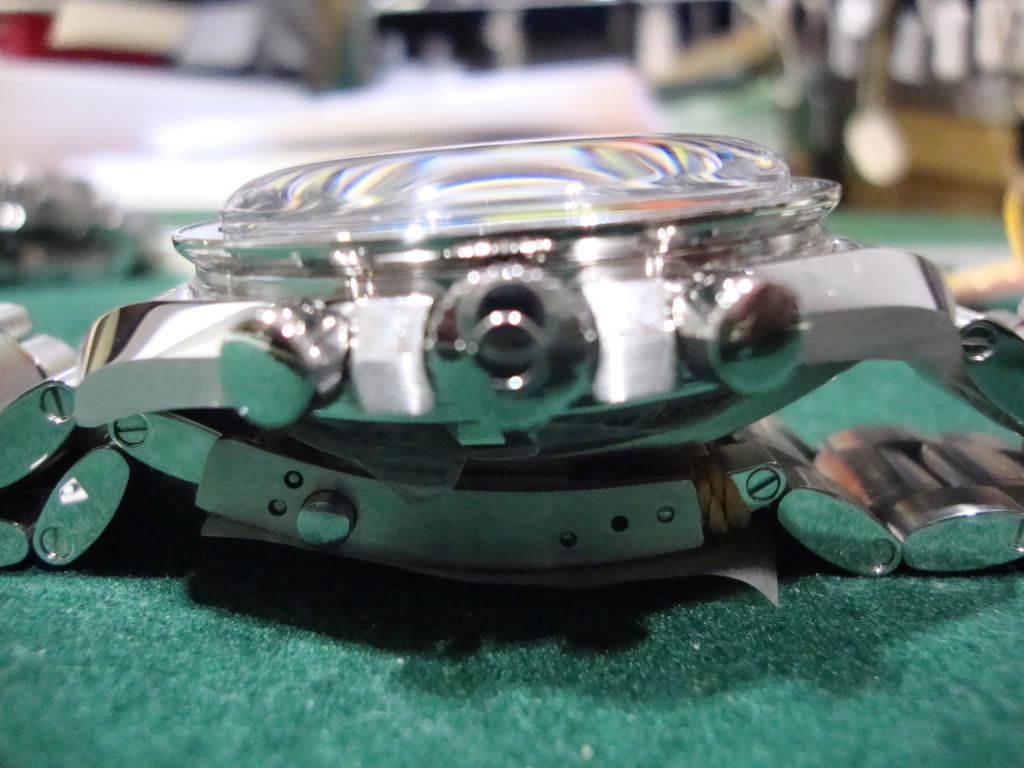Time for a new review! The Omega Speedmaster Professional is one of the most iconic chronographs in the world, with a pedigree few can match. It is also one of the few watches that stay close to it's original design: the fact that a basic design can be essentially kept the same, bar the odd change here and there, is testament to the quality of the original idea. Unfortunately, Omega know just how important the Speedmaster is to their range, and have found an excuse every year for a new special edition, often at highly inflated prices.
Given the importance of the Speedmaster to the Apollo space programme, the 40th Anniversary of the Apollo XI landing is somewhat special, and I would argue more relevant than the most recent Limited Edition commemorating the Apollo-Soyuz linkup. In terms of price, Omega are charging close to a 50% premium over the standard model, and has limited the run to 7969 pieces.
Technical Specifications
*Model Ref: 311.30.42.30.01.002
*Stainless Steel case (also available in a Platinum model, limited to 69 pieces worldwide)
*Tachymetre scale bezel
*Case Diameter: 42mm
*Black chronograph dial, with silver Eagle patch on 9 o'clock seconds subdial, 2:56 GMT marked underneath standard text at 12 o'clock, Superluminova luminous index marks
*Non screw-down crown and pushers
*Hesalite crystal
*Chronograph function, non-date
*Speedmaster bracelet with polished highlights
The Movement
*Cal. 1861 (based on the Lemania 1873)
*21.6k BPH
*48 hour power reserve
*Manual wind
*Non-chronometer rated
The Aesthetics
You can't get much more of a classic chronograph than the Speedmaster Pro - clear, simple dial, matte finish, and completely lacking any delusions of grandeur. It's a humble watch, designed to be used, and that's always something that attracts me to the Speedmaster. The silver patch at 9 o'clock helps to distinguish it from the regular model, and the red writing is always a nice touch. The caseback is also changed from the usual Speedmaster, again featuring the Eagle motif. At 42mm, it has a good wrist presence, and the manual movement allows it to sit low on the wrist, always a plus. There's nothing radical in the design here, only the details show it is something different from the standard watch. The crystal stands quite proud, more so than a lot of sapphire crystal models, but that's to be expected - the 'warmth' of an acrylic crystal is often vaunted, and I can see that too. Gives it a very vintage feel to it. The bracelet is the standard Speedmaster bracelet: mainly brushed with polished highlights either side of the centre links. It's a handsome bracelet, looks unique, but the wide clasp is a well-known scratch magnet, as is the crystal. Saying that, though, crystal scratches are easily remedied with a bit of Polywatch and elbow grease
The Feel
The Speedmaster Pro is typical of modern Omega watches - a nice weight, beautifully enigneered, oozing quality and refinement from every nook and cranny. On the wrist, it is comfortable and unassuming, benefitting from its low stance. The one thing that has probably changed the most over the years is the bracelet, and the one on the Speedmaster is a thoroughly modern affair - solid links throughout, double push button deployant clasp, and satisfyingly rattle free. By comparison, 40mm chronographs seem a little small and clunky by comparison - there's a real purity of design in the Speedmaster Pro, it harks back to the simplicity of older watches. It might lack the complete refinement of the Daytona, but at half the price, it certainly isn't half the watch
Practicality
With the vintage look and feel also come the vintage drawbacks: the lack of a screwdown crown limits the water resistance to 50m, and the acrylic crystal can mark easily. Some might complain about the lack of an automatic movement too, although for me, it gives the watch a little bit more soul. Can this be worn everyday? Yes, but expect it to pick up dings here and there - it's nothing that can't be sorted with a little home maintenance, but it won't be a case of wear and forget like most modern automatic watches. Saying that, let's not forget why it built its reputation in the first place - if it can survive the hostile environment of outer space, it can handle anything Earth throws at it.
Value for money?
My review so far has been mainly focusing on the virtues of the Speedmaster Professional in general: I think it is apt to mention the aspects that make the Limited Edition stand out a bit more. What, exactly, do you get for your extra investment? Not a lot really: Omega are keen to push the idea that the watch is limited, but 7969 watches is a hell of a lot - I can't imagine them selling much more than that of the regular model. You get a few extra visual cues on the watch itself, which makes it stand out a little more, but for £1000 more, it seems like a lot for a different caseback, subdial and dial text. You also get a different presentation box, nothing spectacular, a silver medallion with the eagle motif again, and a commemorative certificate as well. The only differences are very superficial, and I think only serious collectors wanting to have the full set of Speedmaster L.Es would buy this one.
Conclusion
No one can deny that this is a good looking watch, but the price is seriously offputting for me. I don't think the added value for money over the standard model is there, and it's not really limited enough - perhaps a numbered edition would be a more accurate description. My advice? Get the standard model, you'll still get the full Speedmaster experience, and you'll have plenty more change in your pocket
All the best
The GMT Master
Thursday, 27 January 2011
Tuesday, 16 November 2010
Basel 2010 - Some General Comments
Hello, sorry for the long period of time since my last blog update - I intend to make up for it by writing a couple more in-depth reviews over the next couple of days. But firstly, I thought I'd kick things off with a few words about the new watches of Basel 2010, now that they've had chance to reach reality.
I thought it was a slightly poor showing from Omega this year, nothing to really excite the senses, despite a raft of new models. We had yet another limited edition Speedmaster Professional, this time to commemorate the Apollo-Soyuz linkup. The main talking point is its Meteorite dial - a nice idea in theory, but in reality, it falls flat. The problem is, the Meteorite is too dark, and lacks the play of light that Rolex's Meteorite dials have, for example. If anything, it just makes it look as if the crystal has been scratched up. Then we have the price - at a smidge over £5000, you're looking at a £3000 premium over the standard model. Sure, you get a fancy box, but I can't see how it can be over double the price of the standard model, just because of the dial. In my opinion, Limited Edition Omegas being churned out every year is just damaging the collectibility of them, and surely that's what it's all about?
They also introduced a white version of the Plo Prof - not my cup of tea, but I think it may have a niche following. The only downside is that it is going to date horribly - I reckon this one will only stay in the range for 2 or 3 years at max. A new Double Eagle multi-counter chronograph has been launched (same movement as in the Olympic multi-counter chrono that came out a couple of years ago), which gives a very sporty look to the traditionally dressy Constellation line. However, I think with the black contrast bezel, crown and pushers, it looks too much like a TAG F1 for my liking. Plus, it's another chronograph in an already overcrowded range - I don't think it's going to have much of a following. The introduction of an Aqua Terra Annual Calendar is a nice idea, and gives a slightly more useful every day design option compared to the Hour Vision Annual Calendar, but I reckon the price might be prohibitive. Time will tell with that
Rolex's two big model revisions this year were the long-awaited introduction of the ceramic Submariner, both in black and green, and the much needed touch-up of the Explorer. Both subscribe to Rolex's new cutting-edge design ethos, and look brilliant in the flesh. The new Submariner is streets ahead of any other diver on the market (despite what some Planet Ocean LiquidMetal fanboys may say), and is a great example of what a modern sports watch should be. The Explorer has its own niche by being 39mm (sitting between the 36mm case diameter of the old Explorer, and the 41mm of the Milgauss), has a rather nice new matte dial, and, of course, a heavily revised bracelet. There has been some discontent over the size of the hands, but in reality, it really isn't an issue. I was very impressed by both of these models, in depth reviews will follow.
From other brands, the stand out for me was Breitling: they've launched a great looking and very affordable new SuperOcean. I love the choice of contrast colour chapter rings available, and the amount of performance for the price is very tempting. This could well eat into the market of the Omega SMP and the TAG Aquaracer.
There were, of course, plenty of other brands launching, but I feel these were the most worthy of commenting on. Hope you enjoyed the read, and stay tuned for more reviews!
I thought it was a slightly poor showing from Omega this year, nothing to really excite the senses, despite a raft of new models. We had yet another limited edition Speedmaster Professional, this time to commemorate the Apollo-Soyuz linkup. The main talking point is its Meteorite dial - a nice idea in theory, but in reality, it falls flat. The problem is, the Meteorite is too dark, and lacks the play of light that Rolex's Meteorite dials have, for example. If anything, it just makes it look as if the crystal has been scratched up. Then we have the price - at a smidge over £5000, you're looking at a £3000 premium over the standard model. Sure, you get a fancy box, but I can't see how it can be over double the price of the standard model, just because of the dial. In my opinion, Limited Edition Omegas being churned out every year is just damaging the collectibility of them, and surely that's what it's all about?
They also introduced a white version of the Plo Prof - not my cup of tea, but I think it may have a niche following. The only downside is that it is going to date horribly - I reckon this one will only stay in the range for 2 or 3 years at max. A new Double Eagle multi-counter chronograph has been launched (same movement as in the Olympic multi-counter chrono that came out a couple of years ago), which gives a very sporty look to the traditionally dressy Constellation line. However, I think with the black contrast bezel, crown and pushers, it looks too much like a TAG F1 for my liking. Plus, it's another chronograph in an already overcrowded range - I don't think it's going to have much of a following. The introduction of an Aqua Terra Annual Calendar is a nice idea, and gives a slightly more useful every day design option compared to the Hour Vision Annual Calendar, but I reckon the price might be prohibitive. Time will tell with that
Rolex's two big model revisions this year were the long-awaited introduction of the ceramic Submariner, both in black and green, and the much needed touch-up of the Explorer. Both subscribe to Rolex's new cutting-edge design ethos, and look brilliant in the flesh. The new Submariner is streets ahead of any other diver on the market (despite what some Planet Ocean LiquidMetal fanboys may say), and is a great example of what a modern sports watch should be. The Explorer has its own niche by being 39mm (sitting between the 36mm case diameter of the old Explorer, and the 41mm of the Milgauss), has a rather nice new matte dial, and, of course, a heavily revised bracelet. There has been some discontent over the size of the hands, but in reality, it really isn't an issue. I was very impressed by both of these models, in depth reviews will follow.
From other brands, the stand out for me was Breitling: they've launched a great looking and very affordable new SuperOcean. I love the choice of contrast colour chapter rings available, and the amount of performance for the price is very tempting. This could well eat into the market of the Omega SMP and the TAG Aquaracer.
There were, of course, plenty of other brands launching, but I feel these were the most worthy of commenting on. Hope you enjoyed the read, and stay tuned for more reviews!
Saturday, 29 May 2010
Seiko Black Monster Review
As opposed to the usual array of luxury watches I review, I feel compelled to write down my thoughts on what I believe might just be the best value automatic diver's watch in the world. This is a watch that punches far above its weight, and makes similarly priced watches feel poor quality and overpriced by comparison. For me, the Monster is the new Diving Watch yardstick - I now compare all other divers to it.

Technical Features
*Model Ref: SKX779
*Stainless steel case
*Unidirectional rotating diving bezel w/ 60 minute graduations and glowing bezel pearl
*Case diameter: 42mm
*Black dial with Lumibrite baton markers, and luminous hands
*Screwdown crown @ 4 o'clock
*Hardlex Crystal
*200m Waterproofing
The Movement
In a nutshell, it's a non-hacking automatic movement with day and date complications - John Davis' review here is an authoritative walkthrough of the movement, and describes it much better than I could. In terms of accuracy, it's not too bad - mine gains roughly 8 seconds per day
UK RRP: Not sold here, eBay prices tend to lie around £150-180.
The Aesthetics
There's no denying the fact that this is a bold watch - but it does so in a way that befits it's purpose as a serious diver's watch. This watch looks purposeful, honest in its intentions, and I can only admire that in a watch. It's substantial without being overly thick, and sits well on the wrist. Simplicity in the dial, and a large, legible bezel makes it practical for every day use, particularly at night. I can't compliment enough the lume on this watch - it blows anything I've seen personally out of the water. Rolex and Omega are improving their lumes, but for intensity and longevity, no non-radiactive paint compounds can compare. It takes very little to charge it, and even on low light exposure, it can store enough power to be legible in the dark for several hours.
The bracelet is nicely finished - mainly brushed with polished highlights, and it's not trying to imitate another brand, which is always an issue at this price point. It's a little fiddly to adjust, but nothing impossible by any means. The clasp is also very impressive - a foldover push button deployment with a locking clip makes for a very solid and secure fit. However, it should be noted that I have had some problems with the locking clip popping open under stress, though the rest of the clasp remains secure - I believe this is because I need to loosen the clasp a little on account of the warmer weather, so this is by no means a major problem
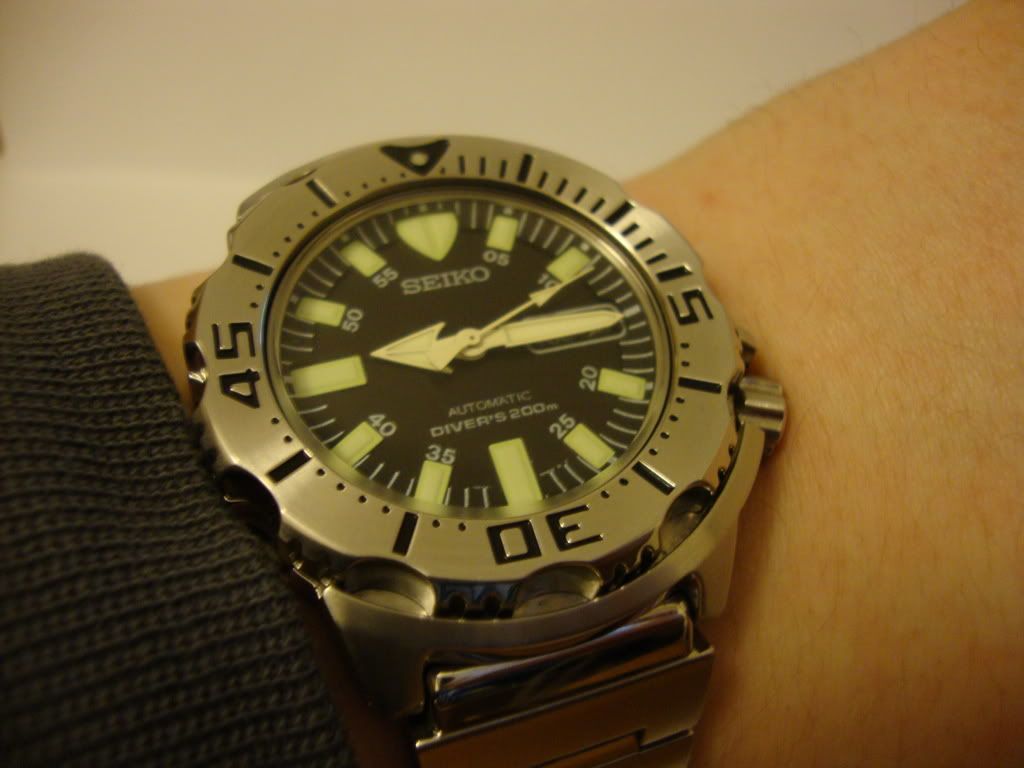
The Feel
As some of you may have worked out by now, I like a substantial watch. This doesn't disappoint - the bracelet links are solid, and they don't skimp on the construction of the case. It's not as heavy as a Deepsea, for example, but it lies at a similar weight, at a guess, as a Seamaster 300m. When properly adjusted, it sits securely on the wrist, and is best with a little movement from the head. I haven't got the world's largest wrists (usually need 1 or 2 links out of most watches), but it doesn't look oversized at all. I think this can be partially attributed to the large bezel, which reduces the dial size to a reasonable level. This certainly doesn't feel as flimsy as a lot of watches at this price point, and I'd argue feels nicer than a lot of watches worth 10 or even 20 times more. It really is an understated hero, and it's a shame that more people don't know about it.
Practicality
I see this as a great daily beater. You can wear it with confidence, and treat it with as little respect as you want, and it'll still keep ticking. Certainly a good idea if you don't want you multiple thousand pound watch getting messed up too badly. Not one for wearing with a suit, but for just about anything else, it'll do its job admirably
Conclusion
I really love this watch, it has so much to offer for such a small price. It having an automatic movement is, for many WISes, a notable plus point, and I feel it is a breath of fresh air from the soulless quartz watches that dominate this segment of the market. Unique styling is a major benefit, and I also see it as a conversation starter. It's eyecatching in a good way, and it has the engineering quality to back it up as well. If you are looking for a cheaper everyday watch, look no further - it may have a couple of minor niggles (the non-hacking movement for one), but it makes up for this with oodles of character and usefulness. Throw away your quartz watches, and embrace the Monster!
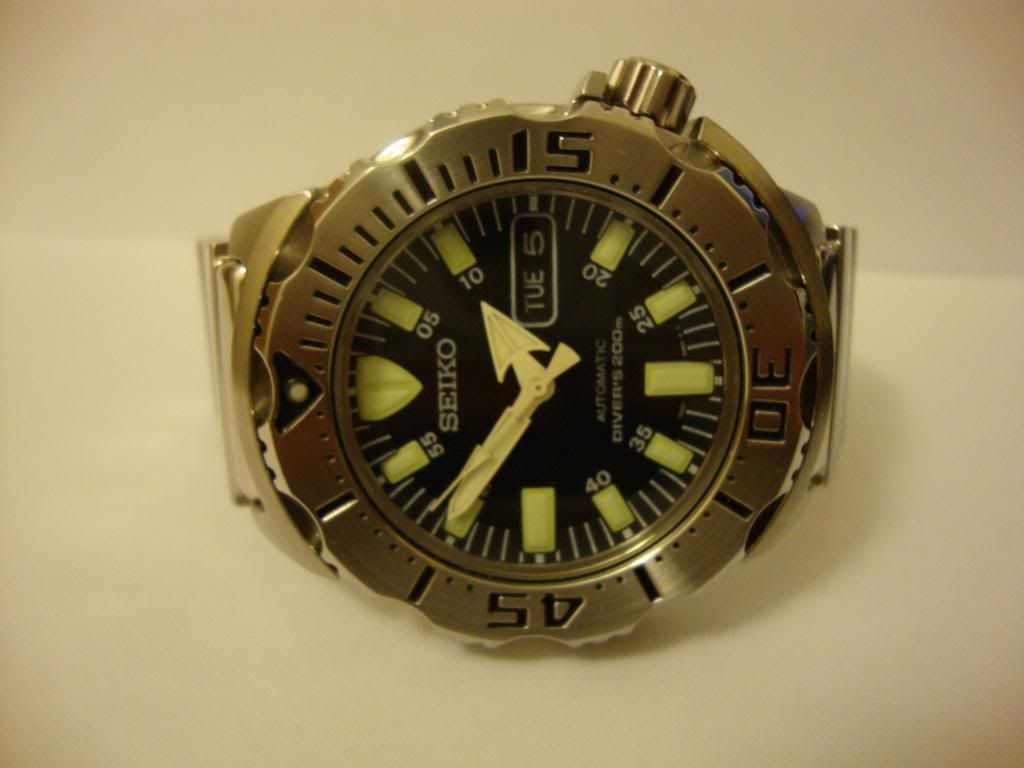

Technical Features
*Model Ref: SKX779
*Stainless steel case
*Unidirectional rotating diving bezel w/ 60 minute graduations and glowing bezel pearl
*Case diameter: 42mm
*Black dial with Lumibrite baton markers, and luminous hands
*Screwdown crown @ 4 o'clock
*Hardlex Crystal
*200m Waterproofing
The Movement
In a nutshell, it's a non-hacking automatic movement with day and date complications - John Davis' review here is an authoritative walkthrough of the movement, and describes it much better than I could. In terms of accuracy, it's not too bad - mine gains roughly 8 seconds per day
UK RRP: Not sold here, eBay prices tend to lie around £150-180.
The Aesthetics
There's no denying the fact that this is a bold watch - but it does so in a way that befits it's purpose as a serious diver's watch. This watch looks purposeful, honest in its intentions, and I can only admire that in a watch. It's substantial without being overly thick, and sits well on the wrist. Simplicity in the dial, and a large, legible bezel makes it practical for every day use, particularly at night. I can't compliment enough the lume on this watch - it blows anything I've seen personally out of the water. Rolex and Omega are improving their lumes, but for intensity and longevity, no non-radiactive paint compounds can compare. It takes very little to charge it, and even on low light exposure, it can store enough power to be legible in the dark for several hours.
The bracelet is nicely finished - mainly brushed with polished highlights, and it's not trying to imitate another brand, which is always an issue at this price point. It's a little fiddly to adjust, but nothing impossible by any means. The clasp is also very impressive - a foldover push button deployment with a locking clip makes for a very solid and secure fit. However, it should be noted that I have had some problems with the locking clip popping open under stress, though the rest of the clasp remains secure - I believe this is because I need to loosen the clasp a little on account of the warmer weather, so this is by no means a major problem

The Feel
As some of you may have worked out by now, I like a substantial watch. This doesn't disappoint - the bracelet links are solid, and they don't skimp on the construction of the case. It's not as heavy as a Deepsea, for example, but it lies at a similar weight, at a guess, as a Seamaster 300m. When properly adjusted, it sits securely on the wrist, and is best with a little movement from the head. I haven't got the world's largest wrists (usually need 1 or 2 links out of most watches), but it doesn't look oversized at all. I think this can be partially attributed to the large bezel, which reduces the dial size to a reasonable level. This certainly doesn't feel as flimsy as a lot of watches at this price point, and I'd argue feels nicer than a lot of watches worth 10 or even 20 times more. It really is an understated hero, and it's a shame that more people don't know about it.
Practicality
I see this as a great daily beater. You can wear it with confidence, and treat it with as little respect as you want, and it'll still keep ticking. Certainly a good idea if you don't want you multiple thousand pound watch getting messed up too badly. Not one for wearing with a suit, but for just about anything else, it'll do its job admirably
Conclusion
I really love this watch, it has so much to offer for such a small price. It having an automatic movement is, for many WISes, a notable plus point, and I feel it is a breath of fresh air from the soulless quartz watches that dominate this segment of the market. Unique styling is a major benefit, and I also see it as a conversation starter. It's eyecatching in a good way, and it has the engineering quality to back it up as well. If you are looking for a cheaper everyday watch, look no further - it may have a couple of minor niggles (the non-hacking movement for one), but it makes up for this with oodles of character and usefulness. Throw away your quartz watches, and embrace the Monster!

Saturday, 1 May 2010
Rolex GMT-Master II 16710 Review
It's been a long time coming, but here's a new blog post! Time for a new review, and it's a horological legend: the GMT Master II 16710, a long time stalwart of the Rolex range until it was killed off in favour of the new 116710 GMT IIc. The GMT has always been a fan favourite, and, having a pristine example to hand, thought it was time to review this truly beautiful watch. The model reviewed had the "Pepsi" red and blue bezel fitted, and was on the Oyster bracelet, with sports clasp.
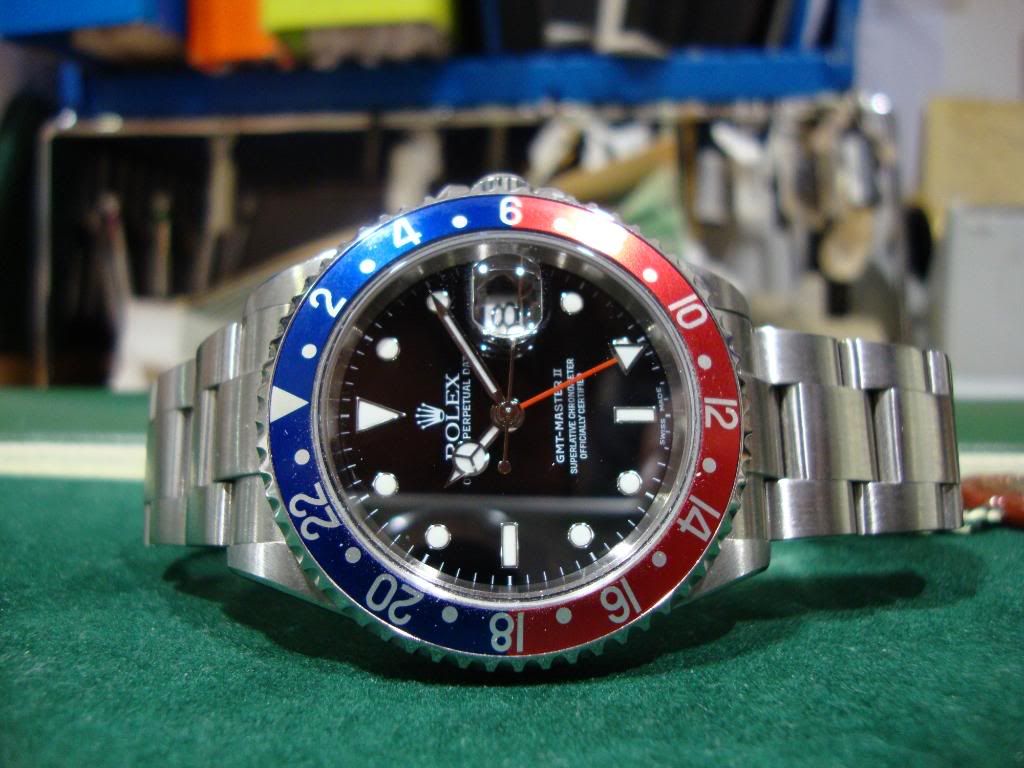
Technical Features
*Model ref. 16710
*Stainless steel case
*Bidirectional 24hr bezel, with choice of blue/red, red/black and black anodised aluminium inserts
*Case Diameter: 40mm
*Black sports dial with luminous (Superluminova) dot and baton markers w/ white gold surrounds
*Twinlock crown with crown guards
*Sapphire crystal with cyclops-magnified date
*24 hr. hand
*Independent hour hand - allows up to three time zones to be displayed concurrently
*Oyster Bracelet
The Movement
*Calibre 3185
*28.8k BPH
*Approx. 48 hour power reserve
*Self winding chronometer rated movement
*Semi-quickset date (done through independent hour hand)
*Nivarox hairspring
UK RRP: Discontinued. 2nd hand value of model posted: £2950.
The Aesthetics
That blue and red bezel combination makes this one of the most easily recognised Rolex models out there - it just screams "GMT." This might be too colourful for some, but I personally love it - practical, and iconic. If blue and red is too much, the other bezel inserts would certainly make it more understated. The numerals on the bezel are a little more subtle than on the GMT IIc, and I think it generally helps make the watch seem more rough and ready - a bona fide tool watch, as opposed to the "useful dress watch" appearance of the GMT IIc.
The brushed bracelet does help with this impression as well, and is classic Rolex sports watch through and through. The dial is clean and readable, even without the "maxi dial" of newer sports models. The red 24 hour hand contrasts nicely with the dial, and as such, is a very easy watch to read at a glance. My only criticism when it comes to looks is the small size of the twinlock crown - it doesn't quite look right on the case, and it is particularly fiddly to operate. Rolex addressed this problem by issuing the GMT IIc with the slightly larger Triplock. All in all, it looks great, and has aged very nicely - I certainly don't feel that it looks like a 20 year old watch, even though it first hit production lines that long ago.
The Feel
On this point, I feel I have to be a bit more critical of the GMT II. Whilst it might look fresh, it certainly feels like a 20 year old watch, much like the other Rolex models that have forgone updates for the time being. The bracelet is very light and rattly, even with solid end links. The clasp is functional, but doesn't inspire confidence - a very thin pressed metal clasp. Whilst purists will quickly point out that it's served the test of time (and they're spot on), I can't help but feel that the clasp seems cheaper than the one on my £150 Seiko Monster. It's not fitting of a watch of this reputation, and isn't a patch on the new clasps that Rolex have brought out. If you can afford it, a new Super Jubilee bracelet would be an excellent choice - it would completely transform the watch. Apart from that, it sits nice and closely to the wrist, and the micro-adjustments on the clasp mean you can get it to fit just right. I do realise this section is highly subjective, and for many people, the light bracelet and clasp won't be an issue: however, for me, if I was spending that kind of money on a watch, I'd want it to feel premium in every aspect.
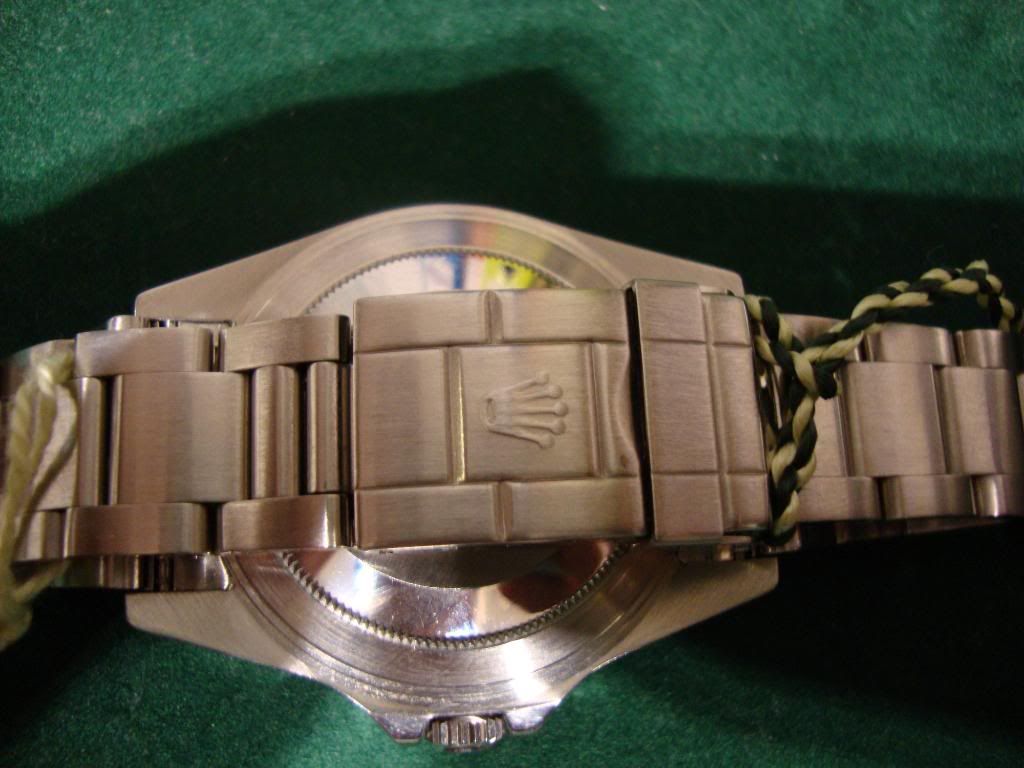
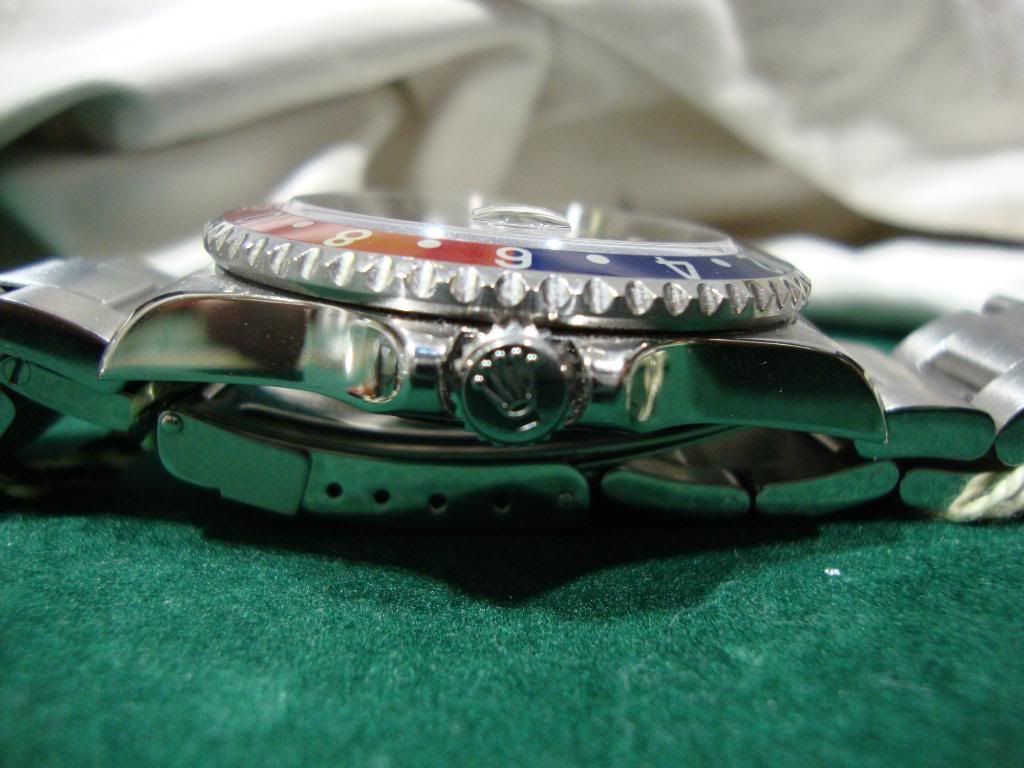
Practicality
Well, what can I say? The GMT has always been Rolex's most practical watch, and this one is no exception. The perfect companion to any traveller, the three time zone feature has made it a long time favourite of commercial pilots. The low profile of the watch makes it a great everyday watch, and I think it looks great with just about anything. The watch is also a real chameleon - get all three inserts, a Jubilee bracelet, and a leather/NATO band, and you've got 9 different looks. Even Panerais aren't that versatile. I think this is probably the watch's strongest point, and makes it particularly unique. Having a brushed Oyster is always beneficial too, it certainy masks the scratches far better than models with polished centre links.
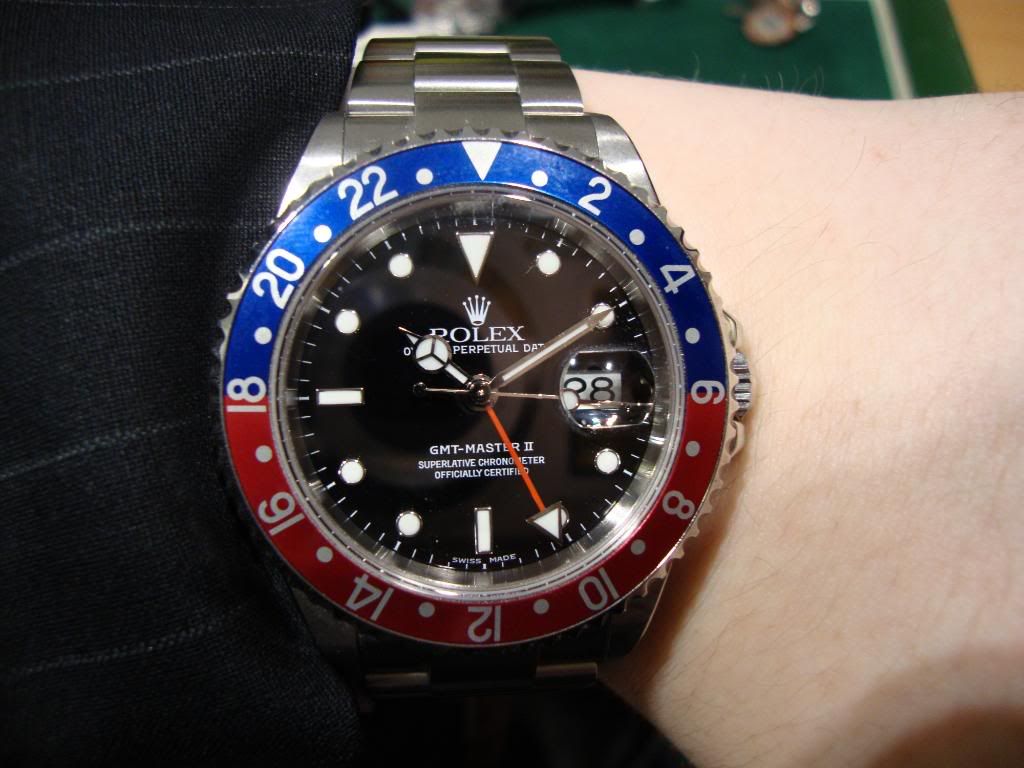
Conclusion
I do like this watch - the history, the looks, the practicality. However, that bracelet keeps holding me back, the one niggling issue, the fatal flaw. If this was on the new GMT's bracelet, I'd have it in a heartbeat. I think I have to come to a similar conclusion to my review of the 16610 - a great 20th Century watch, but feels out of place in the 21st century.
Thanks for reading,
The GMT Master

Technical Features
*Model ref. 16710
*Stainless steel case
*Bidirectional 24hr bezel, with choice of blue/red, red/black and black anodised aluminium inserts
*Case Diameter: 40mm
*Black sports dial with luminous (Superluminova) dot and baton markers w/ white gold surrounds
*Twinlock crown with crown guards
*Sapphire crystal with cyclops-magnified date
*24 hr. hand
*Independent hour hand - allows up to three time zones to be displayed concurrently
*Oyster Bracelet
The Movement
*Calibre 3185
*28.8k BPH
*Approx. 48 hour power reserve
*Self winding chronometer rated movement
*Semi-quickset date (done through independent hour hand)
*Nivarox hairspring
UK RRP: Discontinued. 2nd hand value of model posted: £2950.
The Aesthetics
That blue and red bezel combination makes this one of the most easily recognised Rolex models out there - it just screams "GMT." This might be too colourful for some, but I personally love it - practical, and iconic. If blue and red is too much, the other bezel inserts would certainly make it more understated. The numerals on the bezel are a little more subtle than on the GMT IIc, and I think it generally helps make the watch seem more rough and ready - a bona fide tool watch, as opposed to the "useful dress watch" appearance of the GMT IIc.
The brushed bracelet does help with this impression as well, and is classic Rolex sports watch through and through. The dial is clean and readable, even without the "maxi dial" of newer sports models. The red 24 hour hand contrasts nicely with the dial, and as such, is a very easy watch to read at a glance. My only criticism when it comes to looks is the small size of the twinlock crown - it doesn't quite look right on the case, and it is particularly fiddly to operate. Rolex addressed this problem by issuing the GMT IIc with the slightly larger Triplock. All in all, it looks great, and has aged very nicely - I certainly don't feel that it looks like a 20 year old watch, even though it first hit production lines that long ago.
The Feel
On this point, I feel I have to be a bit more critical of the GMT II. Whilst it might look fresh, it certainly feels like a 20 year old watch, much like the other Rolex models that have forgone updates for the time being. The bracelet is very light and rattly, even with solid end links. The clasp is functional, but doesn't inspire confidence - a very thin pressed metal clasp. Whilst purists will quickly point out that it's served the test of time (and they're spot on), I can't help but feel that the clasp seems cheaper than the one on my £150 Seiko Monster. It's not fitting of a watch of this reputation, and isn't a patch on the new clasps that Rolex have brought out. If you can afford it, a new Super Jubilee bracelet would be an excellent choice - it would completely transform the watch. Apart from that, it sits nice and closely to the wrist, and the micro-adjustments on the clasp mean you can get it to fit just right. I do realise this section is highly subjective, and for many people, the light bracelet and clasp won't be an issue: however, for me, if I was spending that kind of money on a watch, I'd want it to feel premium in every aspect.


Practicality
Well, what can I say? The GMT has always been Rolex's most practical watch, and this one is no exception. The perfect companion to any traveller, the three time zone feature has made it a long time favourite of commercial pilots. The low profile of the watch makes it a great everyday watch, and I think it looks great with just about anything. The watch is also a real chameleon - get all three inserts, a Jubilee bracelet, and a leather/NATO band, and you've got 9 different looks. Even Panerais aren't that versatile. I think this is probably the watch's strongest point, and makes it particularly unique. Having a brushed Oyster is always beneficial too, it certainy masks the scratches far better than models with polished centre links.

Conclusion
I do like this watch - the history, the looks, the practicality. However, that bracelet keeps holding me back, the one niggling issue, the fatal flaw. If this was on the new GMT's bracelet, I'd have it in a heartbeat. I think I have to come to a similar conclusion to my review of the 16610 - a great 20th Century watch, but feels out of place in the 21st century.
Thanks for reading,
The GMT Master
Saturday, 16 January 2010
Rolex Datejust II - Review
The Datejust II is the latest update to the long serving Datejust range, and this is arguably the most radical interpretation of the classic date watch that Rolex have ever done. It has a large size increase over the standard gent's Datejust, and is certainly a striking piece to look at. As such, the watch has divided opinion, with some arguing that it is simply too big to be a dress watch. On the other hand, it has turned what many perceive as a watch for the older man into very much a younger man's watch, and is certainly an interesting addition to the big watch parade. This article will assess features, looks, wearability and build quality, with a few pictures along the way. The model reviewed is the steel and 18Ct white gold model.
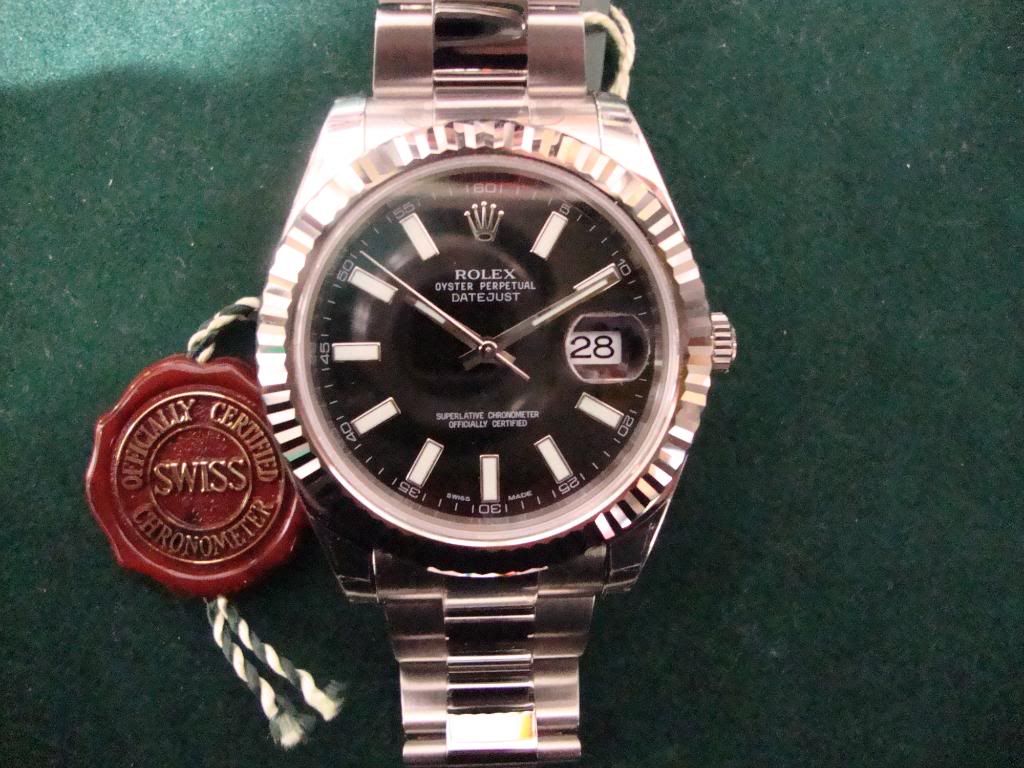
Technical Features
*Model number: 166334
*904 L steel case and bracelet
*18ct White Gold Fluted bezel
*Case Diameter: 41mm
*Choice of dials, model reviewed - Black baton dial, w/ luminous hands and markers, arabics around the circumference
*Twinlock crown
*Sapphire crystal w/ cyclops date magnifier (Antireflective coating on underside of cyclops)
*Oyster bracelet with Oysterclasp
*Waterproof 100m/330Ft
The Movement
*Cal. 3136 (exclusive to the Datejust II)
*28.8k BPH
*Self-winding, chronometer rated
*Quickset date complication
*Parachrom blue hairspring, Paraflex shock absorbers
UK RRP: £4940
The Aesthetics
The two most striking aspects about this watch is how big it seems, and how prominent the bezel is. Although the case diameter is essentially the same as, say, a Submariner or a GMT IIc, it appears larger than them placed side by side. I believe this is largely due to the size of the dial - with the bezel being thinner than the rotating ones on the sports models, the dial stretches further, which gives the appearance of a larger surface area on the wrist. That's not to say that the bezel is a shrinking violet - far from it. The dial to bezel ratios are more biased towards the bezel than on the 36mm equivalent (ref. 116234), making it really sparkle. Some people have expressed that they think it's too prominent, but I disagree - if it was any thinner, it would mean the dial would be even larger, and would make the watch begin to look odd on the wrist. You really need to see the bezel and the way it catches the light to appreciate it - it truly is a thing of beauty.
Another aspect of note is the size of the crown in relation to the watch. Rolex have decided to utilise the Twinlock crown on the Datejust II, the same as on the 36mm model. Whilst it looks spot on on the smaller watch, it seems a little disproportionate on a 41mm case. In a similar way to how they upgraded the crown on the GMT IIc to the Triplock, they probably should have done the same on the Datejust II. Finally, despite the large case diameter, the thickness of the watch is quite reasonable, which should mean it'll still fit nicely under a shirt cuff.
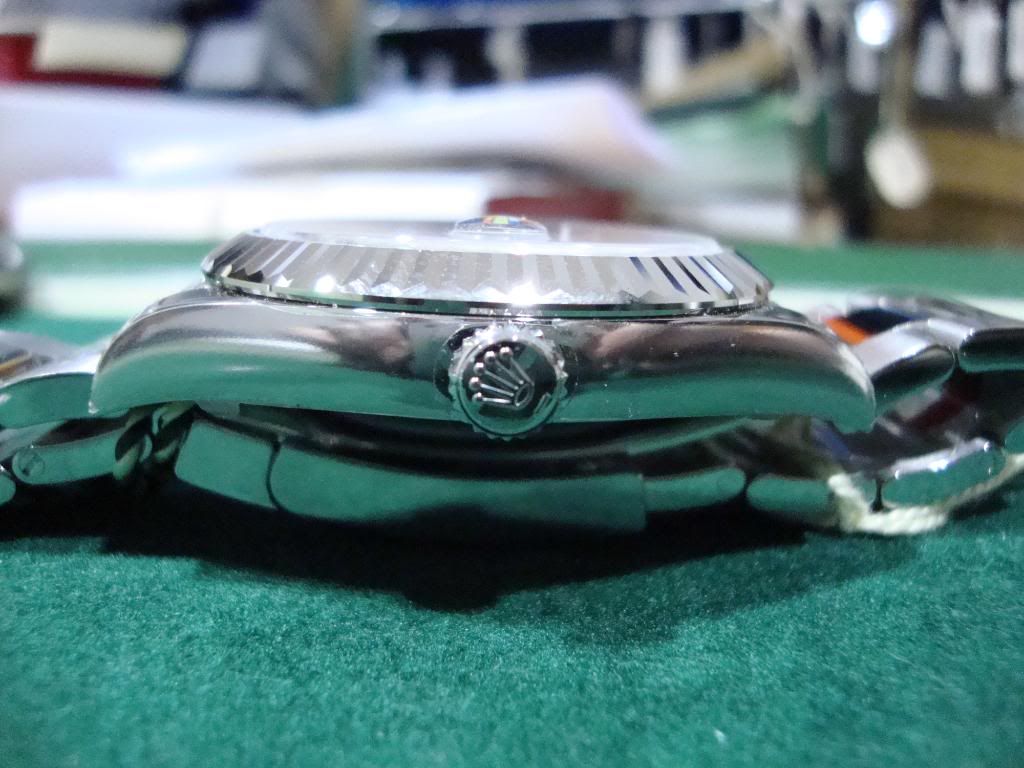
Practicality
I think this watch is a great addition to the range for those who want a smart looking dress watch that's a bit more substantial. I know I have small wrists, and the 36mm Datejust looks pretty good on me, but for men with larger wrists, it might not look right. Yes, it's a step away from classic Rolex sizing, but there's nothing wrong with offering more choice. People are wearing far bigger watches these days, with 45 and 50mm watches becoming more and more popular. In any case, the Datejust II isn't as radical as some would make out, and it is certainly more wearable than a lot of other oversize watches. Crucially, unlike the Deepsea, the thickness of the watch is reasonable, and that's the killer aspect when it comes to wearability.
In terms of comfort, it's on the latest incarnation of the Oyster bracelet - solid end links and solid centre links. Solid, practical, and comfortable - you won't have any problems with hairs getting caught. There is some room for microadjustment on the clasp, and it also features the Easylink - an extra half link that can be concealed or extended. It's not as good as the Glidelock adjustment you can find on Rolex's diving watches, but it means you can still get the watch nice and comfortable. The clasp itself is solid and well engineered - Rolex have gone from producing some of the most basic clasps on the market to some of the best. It certainly gives you a sense of confidence whilst wearing it. The watch is relatively weighty, but not to the point where it's unconfortable - you know it's there, it's a feeling of security.

Value for Money
Okay, at a shade under £5000, it's not a cheap watch. It's about a 20% increase on the price of a 116234, and are you getting more watch for your money? Hard to say - obviously there's more gold in the bezel, and the 3136 is an entirely in-house movement (I'm not entirely sure what differences there are between the 3135 and the 3136, my feeling is that there won't be a significant change.) It also goes with the usual Rolex practice of the larger the watch in a family, the more expensive it is. For the time being, dial choices are relatively limited compared to the 36mm Datejust and only the fluted bezel and Oyster bracelet are available. I expect a Jubilee bracelet and Polished bezel to become available in the future, as well as more dials - keep an eye out at Basel, they might decide to launch some then. In terms of engineering, it can't be faulted. Feels and looks like a premium watch should, and the quality is bound to be extremely high too. Initially, it'll be a relatively exclusive watch, but it won't hold its value as well as the sports models.
Conclusion
I have to admit, this watch isn't for me - just a bit too big for my wrists. However, I can appreciate and understand what Rolex are aiming for with this watch. The oversized watch market is big business at the moment, and, for me, the Datejust II fills a nice niche, and is certainly a lot dressier and practical than a lot of other large watches. It's helped to revitalise a staple of the Rolex range, and I really hope this introduces a new generation to the brand, and shakes off the "old man" image that Rolex seem to have developed recently.
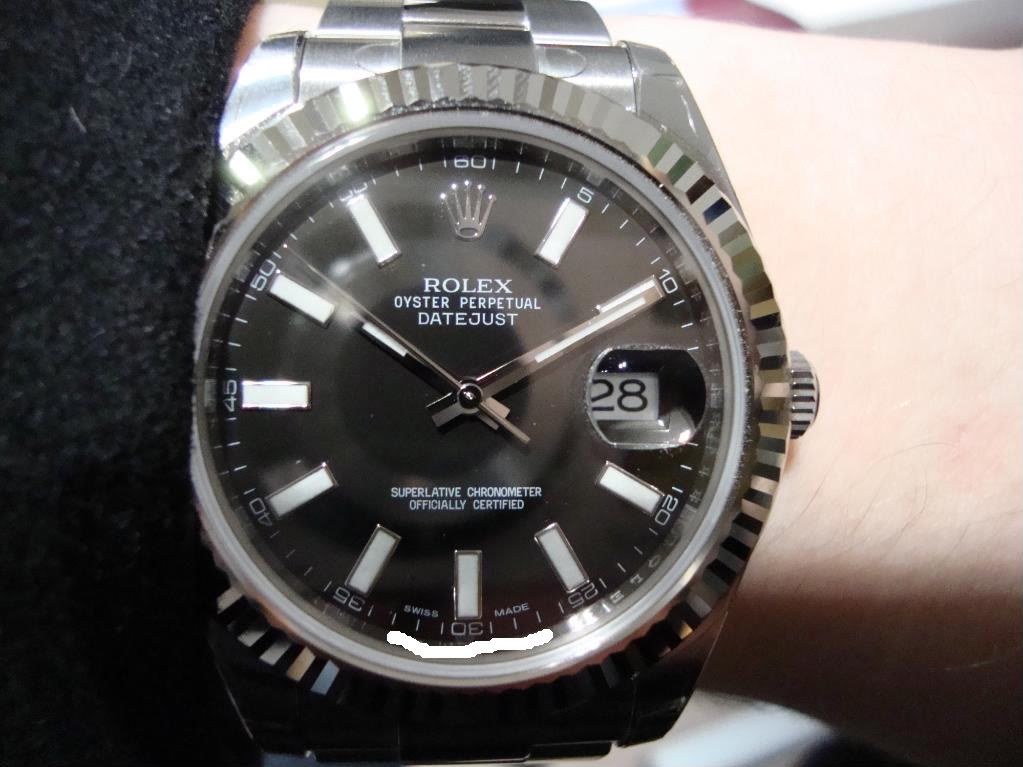

Technical Features
*Model number: 166334
*904 L steel case and bracelet
*18ct White Gold Fluted bezel
*Case Diameter: 41mm
*Choice of dials, model reviewed - Black baton dial, w/ luminous hands and markers, arabics around the circumference
*Twinlock crown
*Sapphire crystal w/ cyclops date magnifier (Antireflective coating on underside of cyclops)
*Oyster bracelet with Oysterclasp
*Waterproof 100m/330Ft
The Movement
*Cal. 3136 (exclusive to the Datejust II)
*28.8k BPH
*Self-winding, chronometer rated
*Quickset date complication
*Parachrom blue hairspring, Paraflex shock absorbers
UK RRP: £4940
The Aesthetics
The two most striking aspects about this watch is how big it seems, and how prominent the bezel is. Although the case diameter is essentially the same as, say, a Submariner or a GMT IIc, it appears larger than them placed side by side. I believe this is largely due to the size of the dial - with the bezel being thinner than the rotating ones on the sports models, the dial stretches further, which gives the appearance of a larger surface area on the wrist. That's not to say that the bezel is a shrinking violet - far from it. The dial to bezel ratios are more biased towards the bezel than on the 36mm equivalent (ref. 116234), making it really sparkle. Some people have expressed that they think it's too prominent, but I disagree - if it was any thinner, it would mean the dial would be even larger, and would make the watch begin to look odd on the wrist. You really need to see the bezel and the way it catches the light to appreciate it - it truly is a thing of beauty.
Another aspect of note is the size of the crown in relation to the watch. Rolex have decided to utilise the Twinlock crown on the Datejust II, the same as on the 36mm model. Whilst it looks spot on on the smaller watch, it seems a little disproportionate on a 41mm case. In a similar way to how they upgraded the crown on the GMT IIc to the Triplock, they probably should have done the same on the Datejust II. Finally, despite the large case diameter, the thickness of the watch is quite reasonable, which should mean it'll still fit nicely under a shirt cuff.

Practicality
I think this watch is a great addition to the range for those who want a smart looking dress watch that's a bit more substantial. I know I have small wrists, and the 36mm Datejust looks pretty good on me, but for men with larger wrists, it might not look right. Yes, it's a step away from classic Rolex sizing, but there's nothing wrong with offering more choice. People are wearing far bigger watches these days, with 45 and 50mm watches becoming more and more popular. In any case, the Datejust II isn't as radical as some would make out, and it is certainly more wearable than a lot of other oversize watches. Crucially, unlike the Deepsea, the thickness of the watch is reasonable, and that's the killer aspect when it comes to wearability.
In terms of comfort, it's on the latest incarnation of the Oyster bracelet - solid end links and solid centre links. Solid, practical, and comfortable - you won't have any problems with hairs getting caught. There is some room for microadjustment on the clasp, and it also features the Easylink - an extra half link that can be concealed or extended. It's not as good as the Glidelock adjustment you can find on Rolex's diving watches, but it means you can still get the watch nice and comfortable. The clasp itself is solid and well engineered - Rolex have gone from producing some of the most basic clasps on the market to some of the best. It certainly gives you a sense of confidence whilst wearing it. The watch is relatively weighty, but not to the point where it's unconfortable - you know it's there, it's a feeling of security.

Value for Money
Okay, at a shade under £5000, it's not a cheap watch. It's about a 20% increase on the price of a 116234, and are you getting more watch for your money? Hard to say - obviously there's more gold in the bezel, and the 3136 is an entirely in-house movement (I'm not entirely sure what differences there are between the 3135 and the 3136, my feeling is that there won't be a significant change.) It also goes with the usual Rolex practice of the larger the watch in a family, the more expensive it is. For the time being, dial choices are relatively limited compared to the 36mm Datejust and only the fluted bezel and Oyster bracelet are available. I expect a Jubilee bracelet and Polished bezel to become available in the future, as well as more dials - keep an eye out at Basel, they might decide to launch some then. In terms of engineering, it can't be faulted. Feels and looks like a premium watch should, and the quality is bound to be extremely high too. Initially, it'll be a relatively exclusive watch, but it won't hold its value as well as the sports models.
Conclusion
I have to admit, this watch isn't for me - just a bit too big for my wrists. However, I can appreciate and understand what Rolex are aiming for with this watch. The oversized watch market is big business at the moment, and, for me, the Datejust II fills a nice niche, and is certainly a lot dressier and practical than a lot of other large watches. It's helped to revitalise a staple of the Rolex range, and I really hope this introduces a new generation to the brand, and shakes off the "old man" image that Rolex seem to have developed recently.

Tuesday, 15 December 2009
A Friendly Dive Watch Comparison: Submariner vs. Seamaster Professional
Firstly, my apologies for not updating the blog more recently - work has been catching up with me, hence why it's been a little quiet over here. However, I have a few new articles I've been working on, which should hopefully be written up within the next few days.
The first of which is a comparison between two icons of the diving watch world: the Rolex Submariner Date and the Omega Seamaster Professional. With the introduction of the black dialled version, as well as Omega's reluctance to push prices up as steeply as Rolex, the Seamaster is looking like a better and better buy every day. Conversely, despite coming to the end of its operational life, the Submariner continues to be one of the most popular models in the Rolex range, and has amassed a serious fanbase since its original inception in 1953. The models I will be reviewing are the Submariner 16610, and the Seamaster 212.30.41.20.01.002.

Technical Specifications (Sub vs. SMP)
Case Diameter: 40mm - 41mm
Cal. Number: Rolex 3135 - Omega 2500
Automatic?: Yes - Yes
BPH: 28.8k - 25.2k
Power Reserve: ~40 hours - 48 hours
COSC Certified?: Yes - Yes
Material: 904L Steel - 316L Steel
Waterproofing: 300m - 300m
Screw-down crown?: Yes - Yes
Helium Escape Valve?: No - Yes
Crystal: Sapphire - Sapphire
Anti-reflective coating?: No - Inside only
Luminous Material: Green Super-Luminova - Blue Super-Luminova
Unidirectional Rotating Bezel?: Yes - Yes
Price (UK RRP): £3890 - £1860
The Aesthetics
With the introduction of the black dial on the SMP, there is very little to distinguish between the two at a glance, at least with an untrained eye. Indeed, the basic dial layout of dots-and-dashes hour markers is the classic dive watch look - simple, practical, legible. The biggest difference on the dial itself is the finish - the Submariner goes for a gloss finish, whilst the Seamaster adopts a wave finish, designed to reduce glare whilst diving.
The other large cosmetic difference on the face of the watch would be the cyclops magnifying bubble on the Sub - although some really don't like this feature, I, for one, think it's an essential part of the Rolex look, and handy for looking at the date quickly. The date window on the SMP is pretty small, and can be difficult to read at a glance. As a general rule, the Submariner is a lot shinier than the Seamaster, owing to the gloss finish and lack of AR coating, and whilst this makes for a "dressier" look, it could be a potential problem for legibility in bright light.
As such, there is little to separate the watches in terms of aesthetics, and it really boils down to personal preference. For me, the Rolex just edges it in this respect.
The Bracelet
It's my personal view that the bracelet is just as important as the watch head when considering a watch - after all, the bracelet and clasp determines the "feel" of the watch, and dictates how comfortable it is to wear every day. Certainly, there is a large difference between the two watches in regards to this.
The Submariner uses a brushed-finish Oyster bracelet, with solid end links, but hollow centre links, whilst the SMP uses an exclusive bracelet with polished higlights and solid links throughout. The first thing that I noticed with the Submariner bracelet is just how light the bracelet felt - a positive for someone who wants a dive-watch without the typical dive-watch heft - but also how rattly it felt. One has to bear in mind that the 16610 was launched 20 years ago, and it really is beginning to feel like its age. Submariner enthusiasts will point out that it's a strong and reliable bracelet, ready to take the abuses of every day life, and I completely agree. However, when you put it against one of the new-style Rolex bracelets, such as the one on the GMT IIc, the Submariner's band just feels cheap.
The Seamaster's bracelet, on the other hand, gives the wearer a feeling of confidence. It's substantial without being overbearing, and sits nicely on the wrist. It also looks a little dressier than the Rolex's, with the polished sections of the links just giving it a little bit of contrast.
There's a similar story with the clasps - the best word to describe the Submariner's clasp is outdated. It still uses the folded-metal clasp, which is wafer thin, and, to be quite frank, would feel wrong on a £500 watch, let alone a near-£4000 watch. Again, it can be argued that it's served it's purpose for a long time, and I won't deny that, but placed against the brilliant Glidelock clasp (see the Deepsea Review if you haven't come across it yet), it feels like an ancient relic:
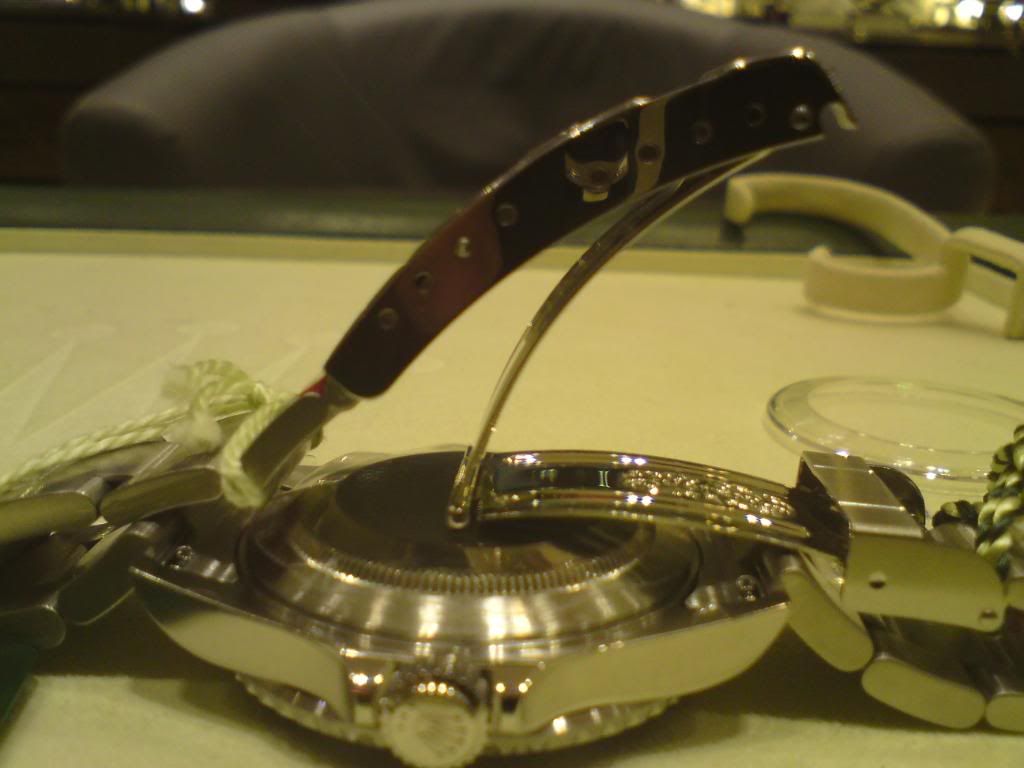
I certainly think that the clasp is the biggest drawback on the Submariner, especially in comparison to the Omega clasp:

The Omega uses a push putton deployment clasp which won't have the same problems with the blades bending over time like the Submariner. It feels like a more heavy-duty clasp as well, and the quality of the engineering can't be faulted. Indeed, some argue that Omega's clasps sparked Rolex's drive for updating their own clasps. Omega wins convincingly here.
The Practicality
The Submariner has long been known as one of the best all-rounders out there - bash it around by day, and it'll still look perfect with a tuxedo. It truly is one of the watch world's greatest chameleons. The "James Bond" aspect has a lot to do with this, and applies to both watches - for someone who wants just one watch that can do everything, then the Sub or the SMP is a worthy choice. Neither are particularly chunky, so wearing one under a cuff isn't an issue. There's virtually nothing to distinguish between the two in this respect. A tie.
Value for Money
As I've asserted throughout the article, in many respects, the SMP is the equal of the Submariner, and in other respects, its superior. Indeed, the biggest difference between the two watches is the price, and I don't think this reflects the quality of the watches - the Submariner certainly isn't double the watch that the Seamaster is. It should also be noted that, due to the use of the Co-Axial escapement in the Seamaster, you get a 3 year guarantee on the Omega, as opposed to the 2 year on the Rolex. When buying new, there's also a bigger scope for discount on a Seamaster as well - most ADs will be unwilling to give more than a token discount on a Submariner owing to its continued popularity. Whilst buying new makes the Omega the rational choice, one also has to take into account resale value, and this is where the Rolex really comes into play. You can always rely on a steel sports Rolex to hold a substantial amount of its value, even a few years down the line. However, the depreciation on an Omega is brutal, and you'll struggle to sell it for muh more than half the RRP a year down the line. In some respects, you are paying extra for the Rolex marque, but it will help to give you a better return should you want to move on further down the line
However, it must be noted that an updated Submariner is expected to be launched in March 2010, hitting ADs in this country in around October/November. Whilst this might spark a small spike in demand for the 16610 as its phased out (in th same way there was a small hype for V-series Sea-Dwellers before the arrival of the Deep Sea), in the long term it will, in all likelihood, give second hand values of the 16610 a beatung. As such, the Submariner isn't quite the safe investment that it used to be.
Omega wins on value for money.
Conclusion
The Submariner 16610 has done the Rolex range proud for the past 20 years, and I'd argue that it's the pinnacle of 20th Century dive watches. The allure that it's created is simply phenomenal, and the fact that it's lasted such a long time pays a compliment to Rolex's overengineering at the time. However, its time has come to an end, and for the past few years, the Seamaster has been the sensible choice. I expect things will shift back into Rolex's favour come Basel 2010, and I can't wait for the rebirth of such an iconic watch.
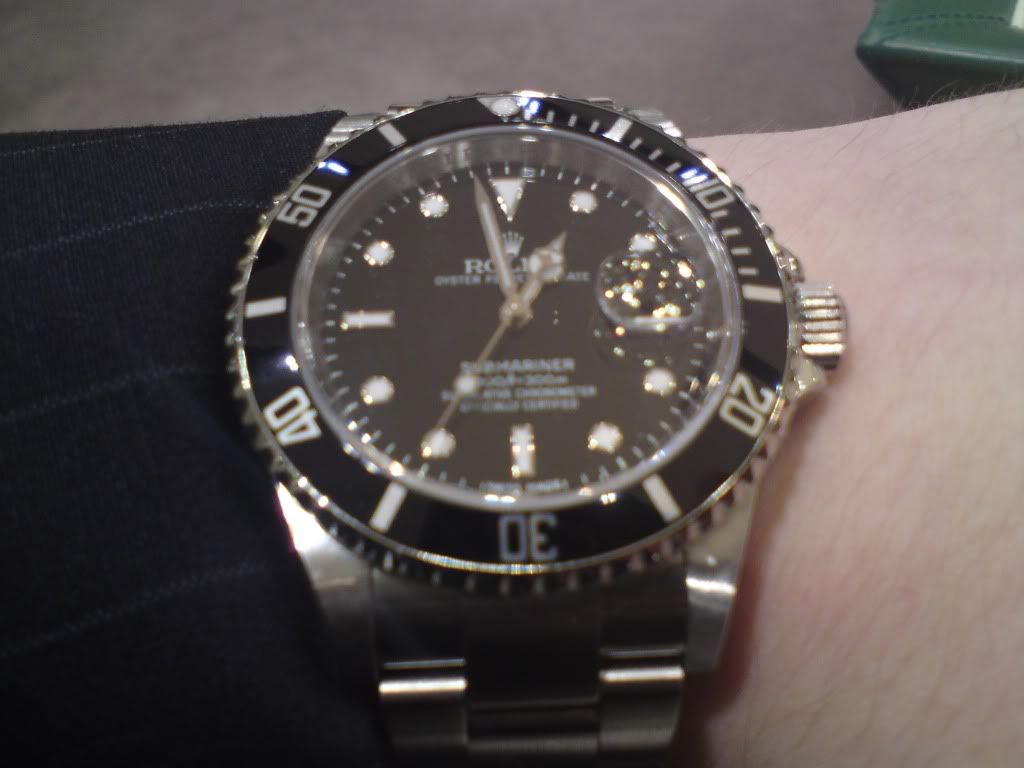
If you asked me tomorrow which one to buy, I'd personally go for the Seamaster - it's quite possibly the best value luxury watch on the market. However, regardless of a rational approach, the Submariner does have the Rolex "magic," and that, for some, will be enough.

On a final note, if you want to get your hands on a new 16610, don't hang around - according to sources on TRF, Rolex USA has already run out of stock of them, and won't be getting any more steel Subs until the new model arrives. I don't know for certain whether this will be the case in the UK - as far as I'm aware, Rolex UK still has supplies in stock.
Thanks for reading
The GMT Master
The first of which is a comparison between two icons of the diving watch world: the Rolex Submariner Date and the Omega Seamaster Professional. With the introduction of the black dialled version, as well as Omega's reluctance to push prices up as steeply as Rolex, the Seamaster is looking like a better and better buy every day. Conversely, despite coming to the end of its operational life, the Submariner continues to be one of the most popular models in the Rolex range, and has amassed a serious fanbase since its original inception in 1953. The models I will be reviewing are the Submariner 16610, and the Seamaster 212.30.41.20.01.002.

Technical Specifications (Sub vs. SMP)
Case Diameter: 40mm - 41mm
Cal. Number: Rolex 3135 - Omega 2500
Automatic?: Yes - Yes
BPH: 28.8k - 25.2k
Power Reserve: ~40 hours - 48 hours
COSC Certified?: Yes - Yes
Material: 904L Steel - 316L Steel
Waterproofing: 300m - 300m
Screw-down crown?: Yes - Yes
Helium Escape Valve?: No - Yes
Crystal: Sapphire - Sapphire
Anti-reflective coating?: No - Inside only
Luminous Material: Green Super-Luminova - Blue Super-Luminova
Unidirectional Rotating Bezel?: Yes - Yes
Price (UK RRP): £3890 - £1860
The Aesthetics
With the introduction of the black dial on the SMP, there is very little to distinguish between the two at a glance, at least with an untrained eye. Indeed, the basic dial layout of dots-and-dashes hour markers is the classic dive watch look - simple, practical, legible. The biggest difference on the dial itself is the finish - the Submariner goes for a gloss finish, whilst the Seamaster adopts a wave finish, designed to reduce glare whilst diving.
The other large cosmetic difference on the face of the watch would be the cyclops magnifying bubble on the Sub - although some really don't like this feature, I, for one, think it's an essential part of the Rolex look, and handy for looking at the date quickly. The date window on the SMP is pretty small, and can be difficult to read at a glance. As a general rule, the Submariner is a lot shinier than the Seamaster, owing to the gloss finish and lack of AR coating, and whilst this makes for a "dressier" look, it could be a potential problem for legibility in bright light.
As such, there is little to separate the watches in terms of aesthetics, and it really boils down to personal preference. For me, the Rolex just edges it in this respect.
The Bracelet
It's my personal view that the bracelet is just as important as the watch head when considering a watch - after all, the bracelet and clasp determines the "feel" of the watch, and dictates how comfortable it is to wear every day. Certainly, there is a large difference between the two watches in regards to this.
The Submariner uses a brushed-finish Oyster bracelet, with solid end links, but hollow centre links, whilst the SMP uses an exclusive bracelet with polished higlights and solid links throughout. The first thing that I noticed with the Submariner bracelet is just how light the bracelet felt - a positive for someone who wants a dive-watch without the typical dive-watch heft - but also how rattly it felt. One has to bear in mind that the 16610 was launched 20 years ago, and it really is beginning to feel like its age. Submariner enthusiasts will point out that it's a strong and reliable bracelet, ready to take the abuses of every day life, and I completely agree. However, when you put it against one of the new-style Rolex bracelets, such as the one on the GMT IIc, the Submariner's band just feels cheap.
The Seamaster's bracelet, on the other hand, gives the wearer a feeling of confidence. It's substantial without being overbearing, and sits nicely on the wrist. It also looks a little dressier than the Rolex's, with the polished sections of the links just giving it a little bit of contrast.
There's a similar story with the clasps - the best word to describe the Submariner's clasp is outdated. It still uses the folded-metal clasp, which is wafer thin, and, to be quite frank, would feel wrong on a £500 watch, let alone a near-£4000 watch. Again, it can be argued that it's served it's purpose for a long time, and I won't deny that, but placed against the brilliant Glidelock clasp (see the Deepsea Review if you haven't come across it yet), it feels like an ancient relic:

I certainly think that the clasp is the biggest drawback on the Submariner, especially in comparison to the Omega clasp:

The Omega uses a push putton deployment clasp which won't have the same problems with the blades bending over time like the Submariner. It feels like a more heavy-duty clasp as well, and the quality of the engineering can't be faulted. Indeed, some argue that Omega's clasps sparked Rolex's drive for updating their own clasps. Omega wins convincingly here.
The Practicality
The Submariner has long been known as one of the best all-rounders out there - bash it around by day, and it'll still look perfect with a tuxedo. It truly is one of the watch world's greatest chameleons. The "James Bond" aspect has a lot to do with this, and applies to both watches - for someone who wants just one watch that can do everything, then the Sub or the SMP is a worthy choice. Neither are particularly chunky, so wearing one under a cuff isn't an issue. There's virtually nothing to distinguish between the two in this respect. A tie.
Value for Money
As I've asserted throughout the article, in many respects, the SMP is the equal of the Submariner, and in other respects, its superior. Indeed, the biggest difference between the two watches is the price, and I don't think this reflects the quality of the watches - the Submariner certainly isn't double the watch that the Seamaster is. It should also be noted that, due to the use of the Co-Axial escapement in the Seamaster, you get a 3 year guarantee on the Omega, as opposed to the 2 year on the Rolex. When buying new, there's also a bigger scope for discount on a Seamaster as well - most ADs will be unwilling to give more than a token discount on a Submariner owing to its continued popularity. Whilst buying new makes the Omega the rational choice, one also has to take into account resale value, and this is where the Rolex really comes into play. You can always rely on a steel sports Rolex to hold a substantial amount of its value, even a few years down the line. However, the depreciation on an Omega is brutal, and you'll struggle to sell it for muh more than half the RRP a year down the line. In some respects, you are paying extra for the Rolex marque, but it will help to give you a better return should you want to move on further down the line
However, it must be noted that an updated Submariner is expected to be launched in March 2010, hitting ADs in this country in around October/November. Whilst this might spark a small spike in demand for the 16610 as its phased out (in th same way there was a small hype for V-series Sea-Dwellers before the arrival of the Deep Sea), in the long term it will, in all likelihood, give second hand values of the 16610 a beatung. As such, the Submariner isn't quite the safe investment that it used to be.
Omega wins on value for money.
Conclusion
The Submariner 16610 has done the Rolex range proud for the past 20 years, and I'd argue that it's the pinnacle of 20th Century dive watches. The allure that it's created is simply phenomenal, and the fact that it's lasted such a long time pays a compliment to Rolex's overengineering at the time. However, its time has come to an end, and for the past few years, the Seamaster has been the sensible choice. I expect things will shift back into Rolex's favour come Basel 2010, and I can't wait for the rebirth of such an iconic watch.

If you asked me tomorrow which one to buy, I'd personally go for the Seamaster - it's quite possibly the best value luxury watch on the market. However, regardless of a rational approach, the Submariner does have the Rolex "magic," and that, for some, will be enough.

On a final note, if you want to get your hands on a new 16610, don't hang around - according to sources on TRF, Rolex USA has already run out of stock of them, and won't be getting any more steel Subs until the new model arrives. I don't know for certain whether this will be the case in the UK - as far as I'm aware, Rolex UK still has supplies in stock.
Thanks for reading
The GMT Master
Labels:
Comparison,
Omega,
Rolex,
Seamaster,
Submariner
Thursday, 17 September 2009
Rolex Sea Dweller Deep Sea
Big. Everything about this watch is big: the size, the depth rating, the price. It's the most extreme diving watch that Rolex have ever offered for sale, the only other watch they've ever made that can outdo it is the Deep Sea Special, which wasn't exactly a daily wearer. It's certainly an impressive watch - but is it as good as the hype would have you believe, and is it a viable watch for the ordinary watch wearer? I'll weigh up the pros and cons and come to my decision, and hopefully it might help yours as well.
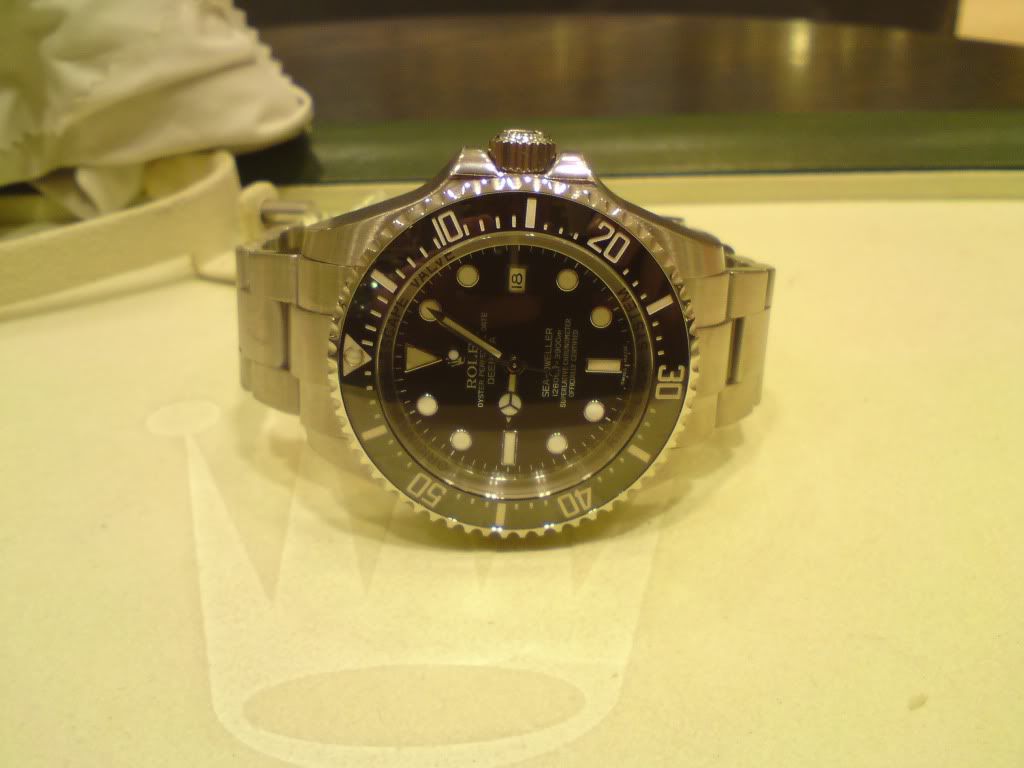
Techincal Details
*Model Number: 116660
*904L Stainless Steel
*43mm Case Diameter
*Unidirectional rotating diving bezel, ceramic bezel insert with platinum numerals
*Maxi Dial and Hands, filled with Chromalight luminous material
*Ringlock system for extra strength at depth
*Automatic Helium Escape Valve
*Domed Sapphire crystal
*Titanium Caseback
*Oyster bracelet with Glidelock clasp
*Oversized Triplock crown
*Waterproof to 3900m/12800ft
The Movement
*Cal. 3135
*Self windng chronometer
*28.8k bph
*Quickset date complication
*Parachrom blue hairspring and Paraflex shock absorber system
UK RRP: £5790
The Aesthetics
Rolex have carried on their traditional diver's watch look: black dial, black bezel, easy to read and easy to see at night. Simple yet functional. However, this really does have a premium feel to it, and I, for one, feel that it is a huge improvement in terms of quality over the previous generation Sea Dweller. The bezel has a lovely feel to it, and glides smoothly into place, and has a lovely shine to it. Wisely, Rolex have kept the bracelet brushed, with only the case and bracelet sides being polished. This, for me, really means it stamps out its tool watch credentials straight away - it's not attracting attention to itself by being flashy, it's here to do a job and do it well. I love the honesty of it.
The size is a real "marmite" factor: some love the size of it, others hate it. In a world of Panerais, Breitlings and other oversized watches, 43mm for a case diameter is relatively modest. It's more the height of the watch which is an issue - I personally think it's just too tall for formal wear, there's no way of getting it comfortable under the cuff of a dress shirt. It absolutely dwarfs my Datejust:
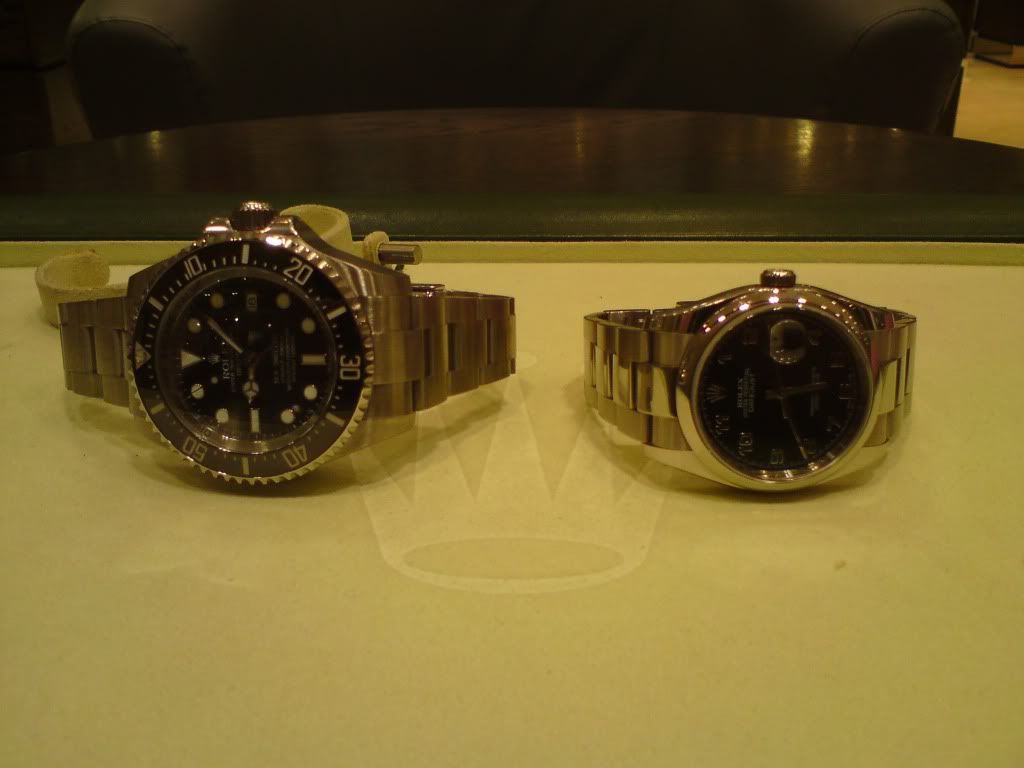
However, it has the look of an industrial piece of engineering, it looks rough and ready to handle anything you could possibly throw at it. This is a watch crying out for outdoors activity, and I think that's the best place for it. In a business meeting, it'd look like a fish out of water, like a bodybuilder at a science fair. In it's element, however, it reigns supreme, and I'm sure the size and weight of it will give the wearer full confidence in it's abilities.
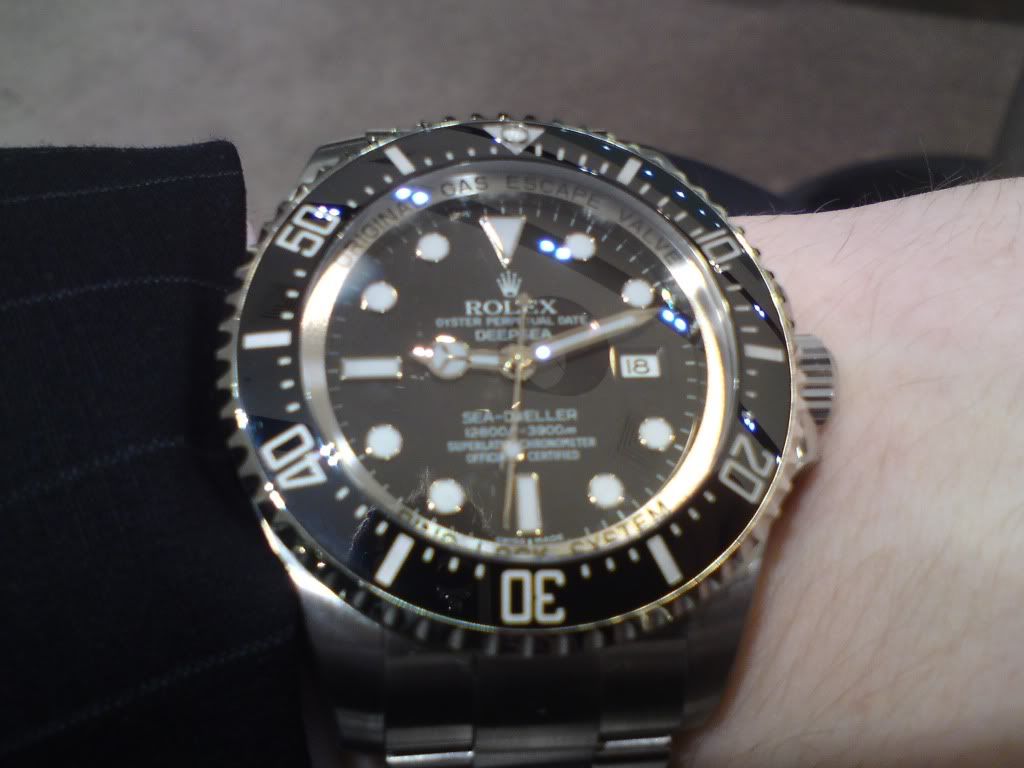
Practicality
As already mentioned above, this isn't the most practical of formal watches. Not something I'd personally recommend as an only watch, but if you had this in conjunction with a more suitable watch for work wear, then you have yourself what I think is a brilliant weekend watch. It's waterproof to a depth no human can physically dive to without a submersible, its brushed finish means scratches will be only a minor concern, the ceramic bezel is extremely durable, and the Glidelock clasp makes a particularly heavy and cumbersome watch surprisingly comfortable to wear. In fact, the Glidelock is such an important feature of the Deepsea, it needs a little section all to itself.
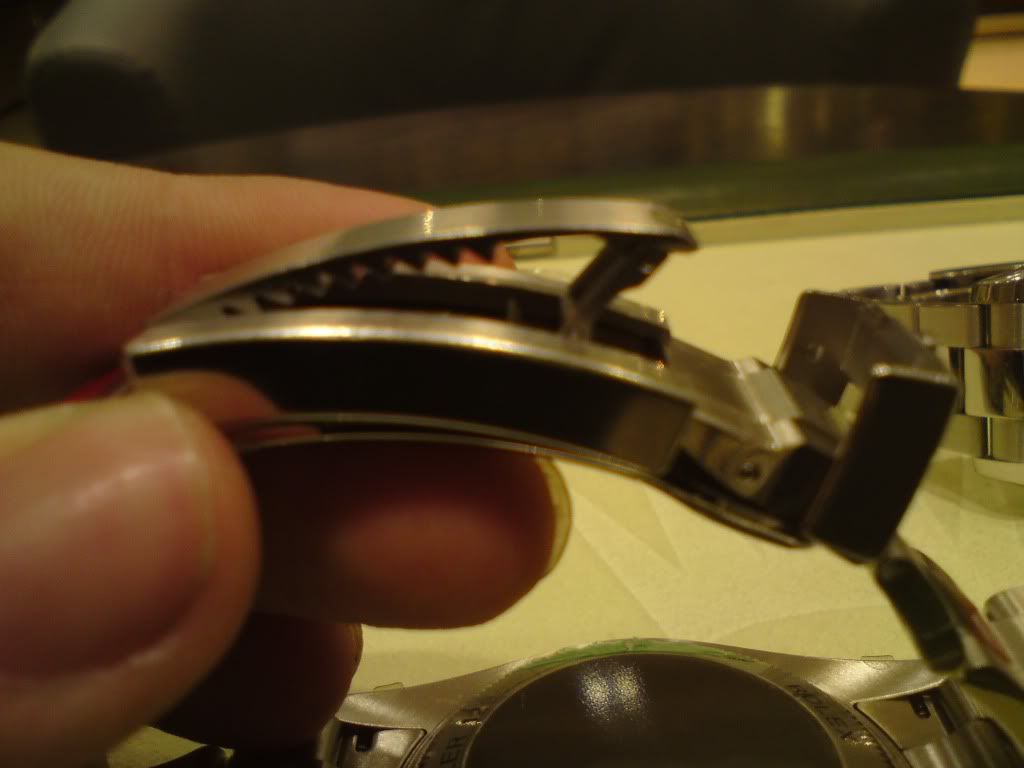
The Glidelock, for me, is the best practical innovation Rolex have developed in years. Whilst the Yachtmaster II's movement is a fantastic piece of horology, it's way out of reach for the average watch colector. The Glidelock, on the other hand, is a revolution in clasp adjustment, and won't just be available on the Deepsea, but the Submariner range as well: the new 18Ct and two tone models already have it, and the new steel version is expected to have it when launched too. Whilst ostensibly designed with wetsuits in mind (the diver's extension link remains with the Glidelock providing an extra 1.8cm of adjustment), it is the perfect feature for an ordinary user. Hot day? Let it out a notch or two. Want to play tennis? Tighten it up. The Glidelock removes the need to move pins in the clasp around - whilst you could get a high level of fine adjustment on the previous generation Sea Dweller, it was a fiddly, complicated and time consuming task compared to the Glidelock. To use it, simply undo the clasp, lift a finger under the edge (as pictured) and slide the link as much as you need. Takes all of 5 seconds. If I was the head of Rolex, I'd have that clasp placed on every single watch in the line up - my only criticism of the clasp is that it's only available on divers' models.
Value for Money
You certainly get a lot of watch for your money. Incredible engineering, high quality parts, bragging rights ("Oh, so your watch can go down to 300m? Nice, but look at mine..."), and that little bit of magic that will appeal to the 10 year old inside you. Of course, it's not a watch for everyone: its critics will cite its size and ostentatiousness as flaws, it'll be simply too much for most. But you need to look at this watch from Rolex's point of view, and I think they've been incredibly clever with this watch. Firstly, they needed a watch that could realistically compete in terms of chunkiness with Panerai and Breitling, and no one can argue that they haven't done that successfully. Secondly, they needed to reiterate their reputation as the makers of watches that can survive the harshest of places - the Deepsea is an excellent example of this, and testiment to their overengineering. Thirdly, they needed to underline their reputation as a maker of the highest quality sports watches, something that the (please forgive me) Submariner and Sea Dweller 4000 lacked. I see the Deepsea as a statement for Rolex's future, a reminder of what they do best. Yes, it's a big price increase compared to the old Sea Dweller, but this is in a completely different league. The Sea Dweller was an excellent watch for the 20th century, but the Deepsea is a 21st century watch through and through.
Conclusion
Excellent technical achievement, but not for everyone. Quite possibly the best engineered tool watch of all time, and truly the new benchmark in terms of sports watches.

Techincal Details
*Model Number: 116660
*904L Stainless Steel
*43mm Case Diameter
*Unidirectional rotating diving bezel, ceramic bezel insert with platinum numerals
*Maxi Dial and Hands, filled with Chromalight luminous material
*Ringlock system for extra strength at depth
*Automatic Helium Escape Valve
*Domed Sapphire crystal
*Titanium Caseback
*Oyster bracelet with Glidelock clasp
*Oversized Triplock crown
*Waterproof to 3900m/12800ft
The Movement
*Cal. 3135
*Self windng chronometer
*28.8k bph
*Quickset date complication
*Parachrom blue hairspring and Paraflex shock absorber system
UK RRP: £5790
The Aesthetics
Rolex have carried on their traditional diver's watch look: black dial, black bezel, easy to read and easy to see at night. Simple yet functional. However, this really does have a premium feel to it, and I, for one, feel that it is a huge improvement in terms of quality over the previous generation Sea Dweller. The bezel has a lovely feel to it, and glides smoothly into place, and has a lovely shine to it. Wisely, Rolex have kept the bracelet brushed, with only the case and bracelet sides being polished. This, for me, really means it stamps out its tool watch credentials straight away - it's not attracting attention to itself by being flashy, it's here to do a job and do it well. I love the honesty of it.
The size is a real "marmite" factor: some love the size of it, others hate it. In a world of Panerais, Breitlings and other oversized watches, 43mm for a case diameter is relatively modest. It's more the height of the watch which is an issue - I personally think it's just too tall for formal wear, there's no way of getting it comfortable under the cuff of a dress shirt. It absolutely dwarfs my Datejust:

However, it has the look of an industrial piece of engineering, it looks rough and ready to handle anything you could possibly throw at it. This is a watch crying out for outdoors activity, and I think that's the best place for it. In a business meeting, it'd look like a fish out of water, like a bodybuilder at a science fair. In it's element, however, it reigns supreme, and I'm sure the size and weight of it will give the wearer full confidence in it's abilities.

Practicality
As already mentioned above, this isn't the most practical of formal watches. Not something I'd personally recommend as an only watch, but if you had this in conjunction with a more suitable watch for work wear, then you have yourself what I think is a brilliant weekend watch. It's waterproof to a depth no human can physically dive to without a submersible, its brushed finish means scratches will be only a minor concern, the ceramic bezel is extremely durable, and the Glidelock clasp makes a particularly heavy and cumbersome watch surprisingly comfortable to wear. In fact, the Glidelock is such an important feature of the Deepsea, it needs a little section all to itself.

The Glidelock, for me, is the best practical innovation Rolex have developed in years. Whilst the Yachtmaster II's movement is a fantastic piece of horology, it's way out of reach for the average watch colector. The Glidelock, on the other hand, is a revolution in clasp adjustment, and won't just be available on the Deepsea, but the Submariner range as well: the new 18Ct and two tone models already have it, and the new steel version is expected to have it when launched too. Whilst ostensibly designed with wetsuits in mind (the diver's extension link remains with the Glidelock providing an extra 1.8cm of adjustment), it is the perfect feature for an ordinary user. Hot day? Let it out a notch or two. Want to play tennis? Tighten it up. The Glidelock removes the need to move pins in the clasp around - whilst you could get a high level of fine adjustment on the previous generation Sea Dweller, it was a fiddly, complicated and time consuming task compared to the Glidelock. To use it, simply undo the clasp, lift a finger under the edge (as pictured) and slide the link as much as you need. Takes all of 5 seconds. If I was the head of Rolex, I'd have that clasp placed on every single watch in the line up - my only criticism of the clasp is that it's only available on divers' models.
Value for Money
You certainly get a lot of watch for your money. Incredible engineering, high quality parts, bragging rights ("Oh, so your watch can go down to 300m? Nice, but look at mine..."), and that little bit of magic that will appeal to the 10 year old inside you. Of course, it's not a watch for everyone: its critics will cite its size and ostentatiousness as flaws, it'll be simply too much for most. But you need to look at this watch from Rolex's point of view, and I think they've been incredibly clever with this watch. Firstly, they needed a watch that could realistically compete in terms of chunkiness with Panerai and Breitling, and no one can argue that they haven't done that successfully. Secondly, they needed to reiterate their reputation as the makers of watches that can survive the harshest of places - the Deepsea is an excellent example of this, and testiment to their overengineering. Thirdly, they needed to underline their reputation as a maker of the highest quality sports watches, something that the (please forgive me) Submariner and Sea Dweller 4000 lacked. I see the Deepsea as a statement for Rolex's future, a reminder of what they do best. Yes, it's a big price increase compared to the old Sea Dweller, but this is in a completely different league. The Sea Dweller was an excellent watch for the 20th century, but the Deepsea is a 21st century watch through and through.
Conclusion
Excellent technical achievement, but not for everyone. Quite possibly the best engineered tool watch of all time, and truly the new benchmark in terms of sports watches.
Subscribe to:
Posts (Atom)

